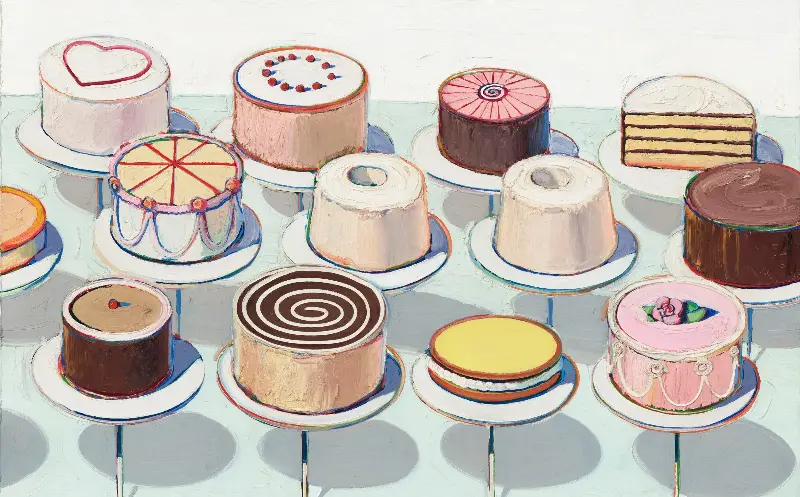
Peppermint sticks and candied apples, dainty cakes and pumpkin pie: these are the subjects of Wayne Thiebaud’s luscious yet unsettling still lifes of the 1960s, the focus of an excellent new exhibition of 21 paintings (plus a handful of works on paper) at the Courtauld Gallery in London. The first museum show of this American’s work in Britain, it also includes depictions of savoury snacks – squidgy-looking hot dogs; sausages and cheese on deli counters – that are both irresistible and brilliantly peculiar.
Thiebaud, who died, aged 101, in 2021, isn’t well known in this country. But, in his homeland, this former commercial artist (who once worked at Walt Disney Studios) is famous. His gloopy paintings of gum-ball and pinball machines, as well as sweetmeats, are associated with Pop art which represented, without apology, the mass-produced stuff of everyday life. At his first show, in 1961, he exhibited alongside Andy Warhol.
Yet, Thiebaud loved London, which he visited annually to attend Wimbledon. (When the art-collecting tennis champion John McEnroe bought one of his pictures, Thiebaud was ecstatic.) He also admired Édouard Manet’s A Bar at the Folies-Bergère (1882), in the Courtauld collection, which depicts refreshments on a marble countertop.
Expertly installed, with a white foot-rail placed below Thiebaud’s pictures that elegantly hints at their settings, the Courtauld’s exhibition begins with some early works. Rendered in an unfamiliar, scratchy style, Pinball Machine (1956) and Meat Counter (1956-59) suggest that, by his mid-thirties, the artist had already found his subject, if not his style. By 1961, this, too, had coalesced.
A classic Thiebaud offers a cropped view of comestibles on a counter or shelf, starkly illuminated and casting long shadows in a way that calls to mind the blinding-white flash of a nuclear blast. Beneath the sweetness – which is meant to cloy – there’s a tang of melancholy, a dash of Cold War anxiety.
Although in reproduction the pictures can appear flat, in person, the juiciness of the paint is unmistakable, as creams and whites are caked (sorry!) over vivid colours, glimpses of which remain visible. This technique feels appropriate for depicting, say, meringue pies, cream cakes, or ice-cream cones. But it seems stranger when rendering a machine’s hard, shiny exterior. At points, the stickiness is almost obscene.
In truth, Thiebaud was never really “Pop”: he avoided smooth surfaces and mediated imagery from, say, comic books or advertising. Instead, he summoned forms from his imagination, so that his paintings have a nostalgic quality, as if evoking bygone childhood treats. They can also be funny. Jackpot Machine (1962), with its Stars-and-Stripes palette, satirically envisions a one-armed bandit as a hectoring four-star general.
Like Jean-Siméon Chardin or Giorgio Morandi before him, Thiebaud successfully reinvigorated (and, in his case, Americanised) the still-life tradition. He also had something piquant to say about the conformism and waste of Western capitalism. “Each era,” he declared, “produces its own still life”. The items in his pictures seem delicious, alluring. But, really, they’re anonymous units on an assembly line – or unloved leftovers.
The Courtauld Gallery, London WC2 (courtauld.ac.uk), from Oct 10
